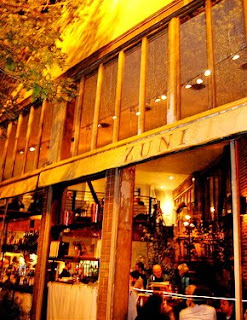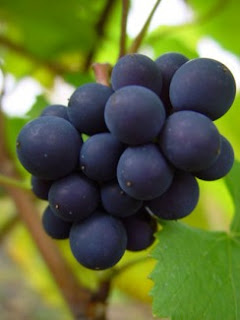 |
| Lodi winegrower Ron Silva talking simple pleasures |
Lodi's ZinFest Wine Festival last May 2011 was a good excuse to talk about one of my favorite subjects: the underrated joys of Zinfandel and cheese matching.
The seminar was called Lodi Wine is Cheese Central Friendly, and it involved four different artisanal cheeses presented by Cindy Della Monica, proprietor of Downtown Lodi's spanking new specialty cheese shop, Cheese Central.
To get get everyone warmed for this organoleptic excercise, we began with a little chat on the sensory components that help us understand just how get the best possible wine and cheese matches. Beginning with the fact that wine and cheese matching is always best understood when you are conscious of the five basic sensations found in all foods and wines -- the sensations of sweet, tart, salty, bitter, and umami (or "savory") -- plus the effects of what we perceive through smell as "flavor."
 |
| Lodi's Cheese Central |
Some of the guidelines touched upon:
- There are probably more cheeses that taste better with white wine than with red, despite the old adage that red wines are best with cheese.
- Derived as they are from milk, cheeses give milky and acidic sensations, which explains why white wines wines varying from soft, creamy textures to sharper, acid edged qualities do well with softer, creamier, or slightly acidic/tart, young cheeses.
- But in the firmer, longer aged, deeper colored and richer flavored cheeses, elevated amino acids tend to come into play, which is why red wines do well with richer, deeper flavored aged cheeses (since unlike white wines, reds are fermented with their skins, automatically giving them deeper flavors, along with oak qualities from barrel aging that match easily with caramelized sensations in aged cheeses).
- The higher amounts of amino acids in cheeses are what gives them a strong taste of the sensation called umami (also re Deconstructing Umami), and the longer aged and deeper flavored the cheese, the stronger the taste of umami in the cheese. This is is why cheeses such as Parmigiano, Manchego and Cheddars are often grated onto foods like pasta: because high umami sensations accentuate food flavors, in the same way that red wines made from grapes like Zinfandel and Sangiovese do.
- By the same token, this is also why sweeter wines do best with cheeses aged with Penicillium molds that create the strong, salty tastes associated with blue cheeses: because salty sensations in foods are always balanced by contrasting sweet sensations in other foods or in wines.
- Earthy, organic, umami enhanced aromas and flavors in cheeses -- particularly those made from sheep or goat’s milk, or else most variations of raw milk cheeses -- find pleasing notes of similarity in wines of parallel qualities (re Wine & Food Matching - Science or Art?). This is why the herby/grassy flavor common to wines like Sauvignon Blanc and Cabernet Sauvignon, the flinty or fusel aromas found in Rieslings, the round stoniness of many Chardonnays, the mushroomy/foresty notes of Pinot Noirs, and the meaty, even gamy or leathery notes typifying many reds made from grapes like Tempranillo and Syrah, all do well with distinctly earthy sheep, goat, or raw milk cheeses.
- Once you get into the grand tradition of cheeses doctored up with additional flavors – like all the varieties of herb crusted Chèvres, peppercorn coated crèmes, cider washed rinds, stout soaked Cheddars, or even truffled Boschettos – the gloves come off, and all the varieties of red and white wines criss-cross in accordance to the dominant flavors that are added. For instance, it makes sense that cheeses coated in black pepper strike partnerships with peppery wines like California Zinfandel and Syrahs from around the world. Italianate herbs (i.e. rosemary, oregano, basil, etc.) will find matches with wines of Italian orientation (like those made from Sangiovese and Nebbiolo). High umami, truffled cheeses practically scream for high umami, earth toned reds like Pinot Noir, or certain types of Chardonnay (especially those from France's Burgundy region).
So what are the best wine and cheese combinations? “Bests” do not exist, but there certainly are a lot of matches that simply make sense. So speaking in terms of specifically Lodi grown Zinfandels, the matches Cindy and I presented at the 2011 ZinFest:
 |
| ZinFest cheeses: Bermuda Triangle, Barely Buzzed, Mimolette and Valdeon |
Mimolette with Uvaggio’s 2009 Primitivo
France’s rare Mimolette cheese, made from cow’s milk, comes in an orbular shape and tanned crust; and when you slice into it looks, for all the world, like a cantaloupe, with its vivid orange flesh tinted by annatto, with a lush, round yet moderately firm, faintly hazelnutty flavor somewhat like Edam, with a savoriness similar to a good Parmigiano. The traditional wine match for Mimolette is a soft, fruity white wine, like a Moscato or Chenin Blanc; but the aged quality of the cheese is deep enough to also embrace a red wine of some sturdiness, especially softer, gentler, fruit forward style of Zinfandel such as the Uvaggio Primitivo (the Primitivo grape being a clonal variation of Zinfandel, producing rounder, fruitier expressions of zinfulness).
Bermuda Triangle with m2’s 2008 Soucie Vineyard Zinfandel
Barely Buzzed with LangeTwins’ 2009 Lodi Zinfandel
Made by Beehive Cheese Co. in Uintah, Utah, Barely Buzzed is an amazingly original, Cheddar style cow’s milk cheese rubbed with intoxicatingly smoky, densifying Turkish grind coffee, adding eye opening volume to the crystallized butter/butterscotchy, caramelized taste of this intensely aged cheese. All well aged Cheddars fall squarely in the “best-with-red-wine” category (which is why wines like Cabernet Sauvignon and red Bordeaux are traditional Cheddar matches), but it was the ultra-rich, smoky/spicy (like strong black tea tinged with exotic jasmine/dried plum/allspice nuances), round yet voluminous qualities of this ‘09 zin that -- sourced primarily from the stately, thickly gnarled trunked 100 year old vines of Lodi's Lewis Vineyard -- that truly made the match.
Valdeon with Van Ruiten’s 2007 Late Harvest Zinfandel
Even if you’re not partial to blue veined cheese, it’s hard not to love Valdeon from Spain: made from a mix of cow’s and goat’s milk to produce a creamy, lusciously soft and silky style of blue that is extremely fine and subtle in the characteristically earthy/salty/sharp qualities of cheeses aged by Penicillium. But a blue cheese it is; and as such, it is best matched by wines with a pronounced degree of sweetness. The Van Ruiten Late Harvest zin fits that description, but its natural sweetness and body is only a third of what is found in, say, a traditional Port; and so it is a sweet red wine that barely falls into the category of “dessert wine.” But with the mild and elegant Valdeon, that parsimoniousness is just right: the subtle qualities of the cheese only emphasizing the natural, joyously juicy, wild berry qualities of the wine, and the wine adding just enough sweetness to balance the salty undertones of the cheese.
 |
| 100+ year old Lewis Vineyard Zinfandel vine |









Comments
Post a Comment